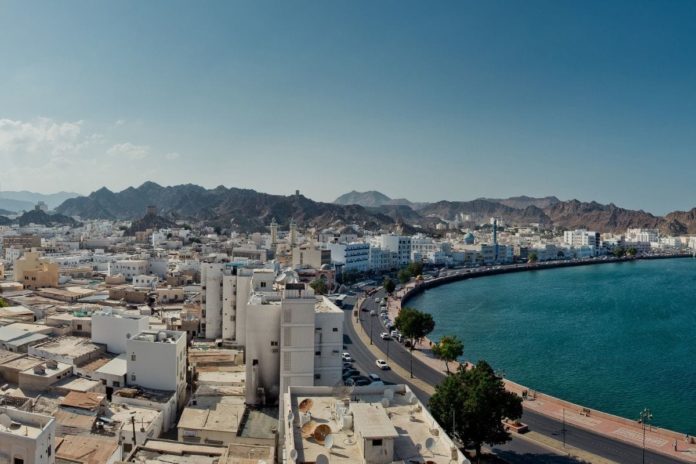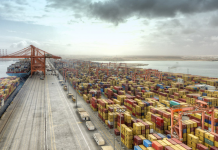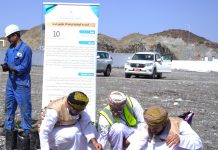The International Monetary Fund (IMF) has predicted that Oman will become the fastest growing economy in the GCC region in 2019. According to the fund’s World Economic Outlook report released in April 2019, the Sultanate’s real GDP is expected to grow by more than 6 per cent in 2019 ahead of its regional peers.
IMF Praises Oman’s Efforts
IMF praised the Sultanate’s economic efforts aimed at strengthening the status of public finance, promoting growth driven by the private sector, creating jobs, promoting economic diversification, improving labour market performance, building human capital, enhancing the business environment and increasing productivity and competitiveness.
The economic activity in the Sultanate is gradually recovering, added the IMF in a statement posted on its website. The provisional data on budget execution indicate an improvement in the overall fiscal balance in 2018. The fiscal deficit is estimated to have declined to about 9 per cent of the GDP from 13.9 per cent of GDP in 2017, reflecting higher oil revenues.
Read: Oman Issues Bonds Worth US $3billion

The statement adds that the fiscal deficit is projected to decline to about 8 per cent of the GDP in 2019, as the impact of low oil prices is more than offset by a decline in spending, one-off revenue, and implementation of a new excise tax on selected products.
External buffers remain adequate. Gross international reserves of the Central Bank of Oman (CBO) increased by about $1.3 billion in 2018 to $17.4 billion in 2019.
Read: IMF Calls for Expeditious Introduction of VAT in Oman
The government’s external assets in the State General Reserve Fund, Oman’s sovereign wealth fund, provide additional buffers. The exchange rate peg to the US dollar is appropriate considering the structure of the economy.
The IMF also praised the Sultanate’s recent adoption of important reforms in the areas of commercial law and arbitration and licensing procedures. “Oman Vision 2040’s emphasis on fiscal sustainability, governance and rule of law is welcome. Further efforts to strengthen the business environment, including by reducing obstacles to foreign direct investment, fostering competition, and further easing trade barriers would help strengthen external competitiveness,” adds the IMF report.
Read more sector reports:
- Oman’s Banking & Finance Sector Outlook
- Industry Insights: Oman’s Manufacturing Sector
- Positive outlook for Oman’s telecoms market 2019-2024: Report
Cautiously optimistic
Higher oil prices, an increase in non-hydrocarbon revenues and spending cut helped the Sultanate improve fiscal discipline in 2018, compared to the last three years (2015-2017). However, the continued fluctuation in oil prices made the government take further precautionary measures in 2019, such as deeper fiscal consolidations, enhancing non-oil revenue, advancing strategic infrastructure projects and promoting further economic diversification.
Oil and gas revenues are expected to increase by 10 per cent compared to 2018. Considering the recovery of oil prices in international market during 2018, the 2019 budget is based on an oil price of $58/bbl, which is 16 per cent higher than the budgeted oil prices of $50/bbl in 2018. The average realised price at the end of November 2018 was $68/bbl.
If the average price of Omani crude does not rise above $60/ bbl during 2019, the government may need to consider taking further action to control the deficit. Non-oil and gas revenue is projected to be RO2.65 billion, reflecting a 2 per cent decline compared to 2018’s budgeted revenue. Whilst the total expenditure is projected to increase by RO400 million to RO12.9 billion compared to the 2018 budget, this is in fact RO300 million (2.2 per cent) lower than actual spending of RO13.2 billion in 2018.

Push for diversification
Volatility in oil prices has led the government to walk a tightrope, carefully balancing expenditures within anticipated revenues and keeping the deficit at a sustainable level. However, in budget 2019, the government aims to allocate sufficient funds to strategic infrastructure projects and continues to push for economic diversification by enhancing participation of the private sector.
The government maintains focus on long-term goals of economic diversification, social development and reduction of the deficit by improving government revenues, while prioritising spending in line with available financial resources. The budget also seeks to improve the investment climate by maintaining an adequate level of public expenditure, promoting public private partnerships and offering support to small and medium enterprises, by assigning a share of government projects to these entities.
The government has considered its investment expenditure as a critical spend, with the purpose of enhancing the investment climate and resultantly enabling private sector to play greater role in investment projects, thereby creating additional job opportunities in the country. The investment spending includes RO1.2 billion specifically allocated for infrastructure projects which are overseen by various government units. Allocations have also been earmarked for utilisation by State Owned Enterprises (SOEs) for the implementation of projects in industrial and services sectors. Such measures will help to boost economic growth and create more jobs. Despite fiscal challenges, the government has retained allocations for development and defence expenditures at the same levels as 2018, which will have a positive impact on economic activities within the country.

Prudent fiscal management
Prudent fiscal management continues to be a priority as the Sultanate seeks to keep the budgeted deficit below 10 per cent of GDP. Measures introduced by the government to boost non-oil revenues, supported by an increased efficiency in controls implemented on public expenditure, have notably reduced the budget deficit in recent years. The actual deficit for 2017 was RO3.5 billion. The estimated actual deficit for 2018 is RO2.9 billion, whereas the budget deficit for 2018 was RO3 billion. The budget deficit for 2019 is expected to be RO2.8 billion.
The projected deficit – RO700 million lower than the 2017 actual deficit – demonstrates the government’s success in controlling expenditures to reduce the fiscal deficit. These efforts are also aided by increased oil prices during 2018. The total expenditure estimated is about 2.2 per cent lower than actual spending in 2018. The GDP is expected to grow 3 per cent in real terms in 2019 and, accordingly, the budget deficit will be approximately 9 per cent of the GDP.
Lower deficit would result in lesser borrowings and lesser drawdowns from reserves, which will help the Sultanate in improving its credit rating further. The medium term objectives of achieving fiscal stability through improving revenue streams and by controlling expenses are aimed at lowering the budget deficit to sustainable levels and reducing the overall public debt. The government has taken certain measures to control deficit by focussing on increasing non-oil revenues and reducing the current spending within permissible levels. The focus on fiscal consolidation will continue over the coming years and will lead to lower budget breakeven prices.
Prudent fiscal deficit management allows the government to increase its expenditure on social welfare and basic services such as education, healthcare and housing. The percentage of total expenditure allocated for these functions are the highest in recent years. Various subsidies currently implemented such as fuel related subsidies, housing and development loans and operational support to state-owned enterprises, are expected to continue. The current expenditure of ministries and government units includes salaries, annual allowances and entitlements, which account for 76 per cent of the total current expenditure. This would have the effect of boosting disposable income in the economy, thereby indirectly assisting in economic recovery.
A continued reduction in the budgeted revenues arising from customs duties reflects the Sultanate’s drive to reduce its reliance on imports. The budgeted collection from corporate taxes is expected to remain constant at RO500 million in 2019. A new category of tax revenue, termed as domestic tax, has been included in the budget. This tax, likely to be the excise tax, may be levied on certain categories of goods. The excise tax is envisaged to come into effect during 2019. While Value Added Tax (VAT) has not been specifically mentioned in the budgeted revenues for the year 2019, its introduction would likely have a positive impact by further reducing the budgeted fiscal deficit.
In terms of expanding the tax base, government has planned application of revised fees of municipal services, amending rules and regulations pertaining to exemptions of tax and customs duties, amending the regulations of lands allocation and revised fees of services provided by Ministry of Agriculture and Fisheries, and Ministry of Health, etc. However, VAT, which was earlier supposed to be implemented in 2019, was not discussed in the budget, as the modalities of its implementation take time and all the stakeholders need to be fully on board with the correct mechanism.
Social spending
However, the government has succeeded in achieving a balance by continuing the fiscal reforms without stopping social spending. The spending estimated in the budget for basic services such as education, healthcare, housing and social welfare accounts for 39 per cent of public spending, and represents the largest portion of the budget. This is an increase from 32 per cent in 2016, 36 per cent in 2017 and 38 per cent in 2018.
On both the education and health care sectors, the government has planned to spend RO2.26 billion in 2019, compared to RO2.24 billion in 2018, while its support to social security and housing needs of its citizens has been budgeted at RO974 million.
This allocation represents the largest portion of the budgeted expenditure. The government is also looking to create 5,000 jobs in the public sector, with a focus on education and the health sector. As part of the government’s policies designed to enhance the skills of Omani job-seekers, the National Training Fund is expected to train 6,170 trainees in order to bridge the gap between education and the job market. These initiatives demonstrate the government’s commitment to supporting citizens. However, to improve the overall social and economic framework, the private sector will have to play a major role in supporting the government’s initiative to fast track economic growth.
In addition, cooperation among high-priority sectors will be enhanced to identify job opportunities, along with current and future requirements. The private sector is expected to play a greater role in creating more job opportunities for the local population as it is involved in all economic activities in the country.
When it comes to the various other subsidies, in spite of abolition of oil subsidy, the government still proposes to spend RO745 million on them. The total subsidy levels budgeted in 2019 remained higher especially with the increase in electricity subsidy because of growing consumption. Several efforts are made towards providing targeted subsides especially after the success of similar implementation in oil products.
Leveraging non-oil sectors
The government’s commitment to the development of non-oil sector gathered momentum during the past few years. Some of the strategic investments towards diversifying the economy away from hydrocarbon sector include Khazaen Economic City project, Salalah Port Expansion project, Duqm Special Economic Zone, in addition to the support extended to establishing multiple manufacturing facilities such as plastics industrial complex, steel factory and pharmaceutical plants. As part of the government’s efforts to achieve economic diversification, Budget 2019 includes allocations for the five targeted sectors identified by Tanfeedh, namely manufacturing, logistics, tourism, fisheries and mining sectors.
Over the past period, a substantial number of projects and initiatives have been implemented either by the government, private sector or SOEs. The tourism sector witnessed the installation of some additional facilities. The recent implementation of Madinat Irfan City project and Mina Sultan Qaboos Waterfront project was also a positive commencement. As for manufacturing sector, implementation of various projects have started, including the Liwa Plastics Industries Complex, a steel factory and a pharmaceutical plant. The logistics sector has also witnessed the implementation of some projects, including Khazaen Economic City project and Salalah Port Expansion project. Furthermore, several projects have commenced in the fisheries sector, which include fish farming projects, and construction of hubs for fisheries products. As for the mining sector, implementation of projects such as the copper mining project and a plant for ceramic tile production has recently begun.
However, projects and initiatives recommended by Tanfeedh rely to a large extent on the private sector providing finance and investments required to execute these initiatives. Besides financing certain essential projects, the government is also taking steps to focus on facilitating procedures designed to improve the business environment and providing support to the respective sectors. The success of diversification efforts will largely depend upon private sector financing and investments in these projects. This is in addition to certain initiatives related to increasing tax revenues. It is also expected that the government will look to amend land allocation regulations (land for commercial, tourism, industrial and agricultural use) and revise municipal services fees, which will support diversification of revenues.
However, for the first time in many years, non-oil revenue budgeted for the year 2019 stands lower than the previous year at RO2.65 billion, compared to RO2.72 billion in 2018, lower by 2.4 per cent. Over the years, Sultanate has been giving increasing importance to the non-oil sector, so as to cut its reliance on the petrodollars but the efforts are taking longer than expected time.
The SMEs sector which the government has been focusing on during the last couple of years will also take benefit from the government’s efforts to promote entrepreneurship in Oman. In addition, the highly anticipated policy changes in terms of public-private partnership law and expansion of the foreign direct investment opportunities into the country will be vital for Oman to achieve economic diversification.
Looking ahead
The Sultanate’s economy has proved to be able to maintain positive economic growth, despite the challenges posed by the oil price fluctuations in the international market. Looking forward to fiscal year 2019, the economy is projected to grow and make progress towards economic diversification.
However, the most important challenge remains Oman’s substantial reliance on oil and gas, which constitutes 74 per cent of total revenues. Any deviation in oil and gas prices will have an impact on economic policies and growth. With the sharp fall in oil revenues since 2014, the government has followed a policy of adjusting its expenses without any social and economic implications.
These challenges have to be managed through ongoing diversification of government revenues. Upskilling of the youth, so as to meet the industry demands and generate valuable employment, continues to remain a priority. Investment in higher education to bring in world-class institutions, focus on vocational training programmes and support from the private sector are key to overcoming this challenge. The cost of expected government borrowings envisaged to meet the fiscal deficit will play a vital role in the fiscal policy measures going forward, adds Jain. Quick implementation of key projects and continuous enhancement of investor-friendly policies will go a long way, in order to make Oman an attractive economy in the region.
 This article was first published in Progress (Al Takkadum) 2019-2020. To read the e-version of the magazine, visit: progressoman.com
This article was first published in Progress (Al Takkadum) 2019-2020. To read the e-version of the magazine, visit: progressoman.com








[…] READ: Oman Economy on a Growth Trajectory […]